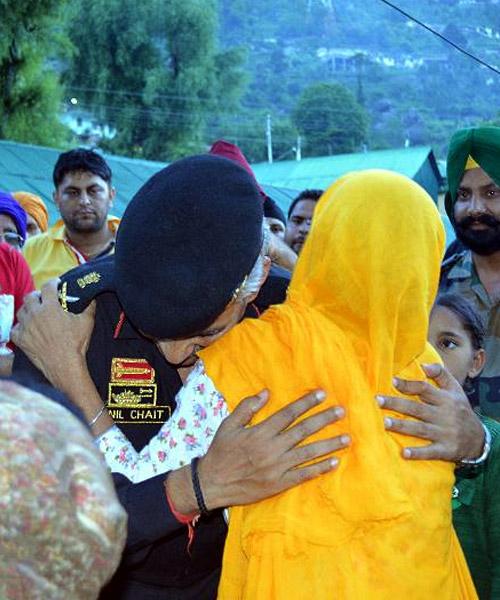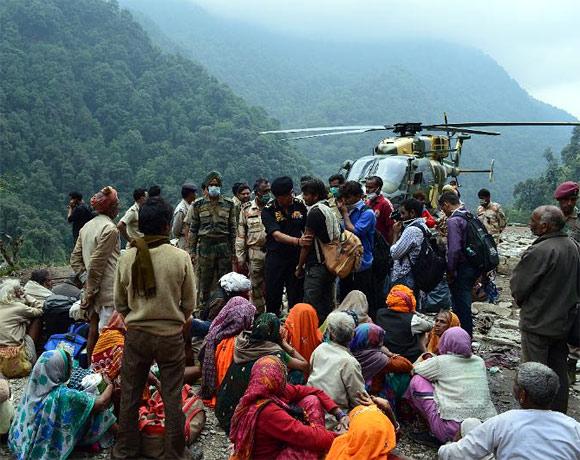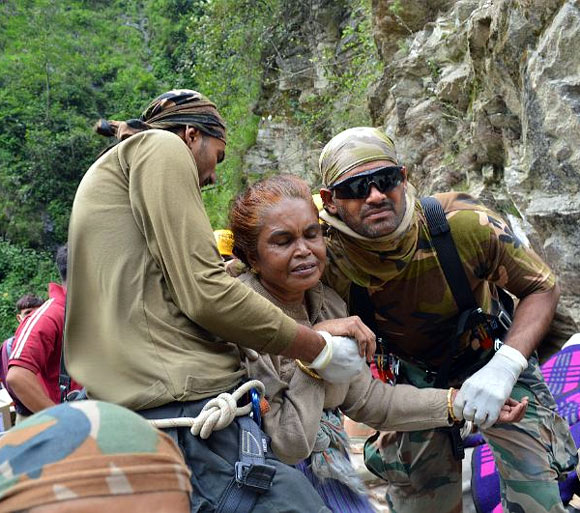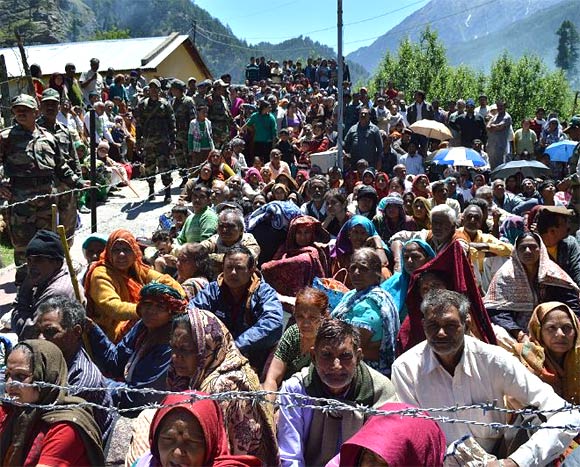 | « Back to article | Print this article |
Uttarakhand catastrophe: The horror, and the new gods
Each yatri had to tell more than his and her story. Heaven it was once which has turned into a burial ground for the living. With all the advancements in technology, all that glib talk of disaster management, the towering Indian conquering the world with his brilliance and high-end acumen, the fact is we failed our people in crisis. Ultimately the armed forces had to be deployed, who emerged as the new gods. Tarun Vijay returns from Gauri Kund with this grim account
The chopper crash killing 20 rescuers on board has once again brought the horror of the situation prevailing in the Kedarnath region. Everyone saluted the brave-hearts who laid down their lives in the service of common Indians. They have emerged as the new gods of Kedarnath. The eye of Shiva that protects, not destroys.
Everything that shouldn’t have happened, happened in Uttarakhand.
The monsoon was forecast a fortnight later, yet with the cloudburst the Chauri Bari lake (also known as Gandhi Sarovar) sank into KedarValley burying thousands under the huge boulders and a wall of water that fell on pilgrims from above. That was on June 16.
The first help reached them on the evening of June 19.
The rush of pilgrims should have been a little less in the week closer to the rains, yet it was overwhelmingly crowded and the road to Kedarnath was like a sea of people of all colours, countries, provinces and castes.
As everyone knows, the monsoon often wreaks havoc in this part of the state, so the disaster management team should have been very, very alert, its plans in place and the manpower smartly distributed at all the vulnerable points so that in any eventuality the rescue teams are rushed to the spot without wasting a second.
None of the areas that are vulnerable and known as the most crowded places in peak season, had any disaster relief team stationed and well-equipped, no emergency plans were ever prepared; no disaster control room was even designed to serve professionally in the last one decade.
The district magistrate of the area should have been the first to sound the alert, and to caution pilgrims when the first news of the rains arrived.
But he suddenly had a massive stroke at the most critical moment and was brought to Dehradun for treatment.
In the shadow of a terrific calamity, the state government took five days to appoint a new DM. The most precious time to control and minimise the damage was thus lost.
The incident also proved that in spite of being the place of highest reverence for Hindus, that brings more than 400 million faithful from across the globe every year, the area didn’t have a hospital to provide emergency treatment to people in distress. Even a district magistrate had to be rushed to Dehradun.
Think of the common citizens and pilgrims in such a situation.
The nation, ie, the political masters who take decisions to send help in such situations, and the media, that creates the atmosphere to have an appropriate response by society, should have been completely focused on the incident.
But when the dying people needed urgent response in Kedarnath, politicians and the television channels were busy responding to Nitish-Modi-Advani-RSS issues and discussing the future of NDA post the JD-U ‘s secular divorce.
Nothing mattered to them as important and as engaging as this political potpourri.
TV Channels relied on their junior-most reporters, sometimes stringers based in the state, they even used Facebook photos as exclusive ‘breaking news’ clips. But a Pakistan election gets their chief editors, principal political editors and the highest-ranking senior analysts to go to Islamabad and report from there.
Plus, the reports from the state were too noisy and haphazardly presented. For Delhi station directors, Kedarnath didn’t deserve a well-planned and top-slotted reporting till the third day was over.
In market-driven stupid shows, the media in Delhi was discussing ‘didn’t I tell you a hundred years before that unless you follow what I have been prescribing such calamities will occur’ and giving a push to ‘green journalism’ in a sordid drama of one-upmanship. And another began a discussion on Rahul-Modi contributions to help Kedarnath victims. They were shameless enough to use a tragedy to earn more masala-driven TRPs.
The TV channels hardly showed any sensitivity to the victims, their relatives and the local residents of Gupt-Kashi, Ukhimath, where almost every home lost a member. Weeping mothers, old men with hardly any energy to speak, wailing families and extreme shows dominated the screen. The print media, on the contrary, was more sincere and sensitive to the situation.
Please click on NEXT to read further...
Uttarakhand catastrophe: The horror, and the new gods
It all resulted in chaos.
Chaos that prolonged the dark night of death.
Chaos that saw the most excruciatingly painful and torturous five days for the thousands of pilgrims.
And that perhaps increased the toll of the dead to an unimaginable count.
And look at how our people, our citizens and our kith and kin died.
Usha Soni’s husband died in her lap; he had dysentery and no anti-diarrhea medicine was available.
Sohan Lal Vyas from Udaipur saw her son, daughter-in-law, sister’s son and sister getting buried in the water-wall that came with a huge gush of mud and pebbles.
A mother was holding her little baby at Kedarnath, and to make secure that hold she tried to clutch the Nandi idol, but in that fraction of a second the water flow took away the wailing child.
Khushboo Sahay of Varanasi was swept away with her husband and son; she was found two days later on the river bank, unconscious, by army men and revived.
The people on the 14-km long trek to Kedarnath, a huge sea of faithful, vanished into the watery assault that came with unimaginable force and speed, sweeping away vehicles as if they were made of cardboard.
Those who were fortunate to be alive experienced Pralay -- the end of Earth.
A family of eight was washed away with a 10-year-old boy being the lone survivor.
For six days people at Gauri Chatti, Bhairav Ghati, Rambari, Gauri Kund were left to their own devices. No food, no water. All around dead bodies lay scattered. Bodies of dead ponies and scores of other animals turned the area into the most horrendous and frightening one. No one could even airdrop pamphlets with instructions, guidance and hope. No one conveyed to them, ‘We are coming. We shall bring all of you back home safely’.
Porters and pony-wallahs assaulted the women. Pilgrims were taken to wrong, lonely routes to deprive them of their belongings. A porter took 16,000 rupees from a group of 10 from Patna, one of them Narendra Singh, a former chief manager of the State Bank of India, just to show them the correct path to Sonprayag. Fingers of dead bodies were cut to take out golden rings. Their pockets were emptied. An ochre-robed man was found with 80 lakh rupees and promptly arrested.
The aircraft pressed into service to evacuate pilgrims were small, like three- to six-seated choppers. They had a refuelling problem. The director general of police, Uttarakhand, told me and urged for help. I spoke to the prime minister to facilitate the ATF airlifted to higher regions to save time and evacuate more people.
It goes to the credit of our PM that he immediately conveyed this to the cabinet secretary and the needful was done.
Thousands were stranded in Badrinath, Gangotri and Kedarnath regions. It was only after the death toll rose too high and the national media finally understood the seriousness of the catastrophe, that more choppers were brought in to make more sorties.
June 22 and 23 were hectic for Kedarnath, but thousands of stranded pilgrims at Badrinath were told to wait, as ‘they were safe’. We left Gupt Kashi by road on the 24th morning early, at 4.30 am. Hundreds of rescued pilgrims were with us, in vehicles. Old and young women who have lost sons, daughters, fathers and parents and all family members. The tragic stories were endless. Hardly 45 km later we faced huge landslides.
In the entire 200 km stretch only one JCB road clearance machine was deployed. It was working at its peak speed, but still would have taken a day to clear the huge blockades if an army officer, Col Anil Mehra, had not put into action two other JCBs lying idle in a village as they were ‘privately owned’. That’s the difference between a babu-government and the army man, everyone realised.
A young kid, Shivam Bisht, was crying with pain. He had suffered major knee injury at Kedarnath and a bleeding sore in the stomach. By chance a doctor, which had come to Gupt Kashi from AIIMS to help pilgrims, was with our convoy. He did some first aid. Spoke to state’s health minister Surendra Singh Negi, and he assured that once the boy reaches Dehradun he will be provided all medical help and also special financial assistance.
Please click on NEXT to read further...
Uttarakhand catastrophe: The horror, and the new gods
The agony that began in Kedarnath was unending.
Have they brought all yatris from Kedarnath? Perhaps not. Some pilgrims were still reported to be in Bhairav Ghati and beyond. With the monsoon beginning, they would be needing immediate help. They might not be having any food, shelter and warm clothes. Who is going to provide all that?
And what about the dead still buried in Kedarnath area? The bodies have begun to decay and stink. Army officers say unless they are cleared in the next two to three days, a massive attack of infections may engulf the entire state.
It’s only on the fourth and the fifth day that some NDRF teams were sent to Guptkashi, Kedarghati, Gauri Kund and Gangotri areas. Doctors’ teams from the Indian Medical Association, AIIMS, Gangaram (New Delhi) too arrived at some places like Guptkashi. But the ordeal of the pilgrims at Gauri Kund, Ram Bari, and Jungle Chatti remained unspeakably painful. No shelter, no tents, out in the open without even a sheet of cloth to cover in that wintry, windy climate. The shopkeepers, lodge-owners, were either dead or gone to safety.
Everywhere it was a spine-chilling reign of fear, bad memories and hopelessness. People were defecating anywhere. Water was down there in the Mandakini river. No one was in a condition to hold the hands of the other. A chopper came but the minister took his two relatives and flew away. More sorties and more chaos. Thousands of stranded people, and a clamour to board and leave the hell. The ‘me-first’ push of the crowd eager to reach a safer zone can’t be described, it can only be felt.
The only gods of succour and life-providing bliss were the men in olive green, the army, the ITBP personnel and the RSS swayamsevaks. Like angels they did everything that was possible in that situation. RSS youngsters were the first to reach Gauri Kund and provide food, water and solace to dejected, fatigued, yatris enveloped in hopelessness. And so were the Gayatri Parivar, local NGOs, the police association, college student unions, etc. It’s a tragedy that driven by hate and an ideological apartheid, the wonderful and selfless contribution of the RSS was completely ignored by the media, though the army men gave them a hug and cooperated with them.
The IAF and army saved thousands of people. Crossing ferocious streams and rivers on a string of wire with old, young and the children clinging to them; like monkey cubs, they dawned on the scene as angels. But too many were to be rescued and too less was the number in proportion to the need and calamity-struck people.
The security personnel manning the air-rescue had to have some rule -- and one was to get the women, aged and ailing onboard first. It divided the families. Men and many times young women of the family were left behind. Seemingly young were asked to trek down up to Sonprayag from Gauri Kund, about 14 to 16 km, passing through a bit of forest and negotiating a high hill. In Gangnani area, seemingly youthful ones had to trek approximately 75 km to reach safety.
Though some said it was forgotten that after a painful stretch of five days, without food, even the young were half-dead. The mental stress, deadly dance of agony, and dark fears of life coming slowly to a painful end sap away all the energy that you once had.
But they had no other alternative. The forces that were there to provide safety were left with no other option.
Still some were lucky to be airlifted and some had to walk down to Gupt Kashi. They were a picture of lifeless, darkened and blank-eyed moving bodies.
They needed a shoulder and a few words of consolation.
They needed a blanket of hope and warmth, the hug of a relation. A relationship of being a fellow Indian.
Please click on NEXT to read further...
Uttarakhand catastrophe: The horror, and the new gods
The people of Gupt Kashi did try to help them wonderfully. The city, a small buzzing town of pundits, ritual performers, shopkeepers of religious needs like dhoop, agarbattis, pooja samagri, lodge-owners of Kedarnath, helpers, guides, members of temple committee, employees of local government offices was enveloped in grief.
Almost every home in this region, particularly Gupt Kashi and Ukhimath, has lost someone in the family.
They were desperately scouring the lists getting updated every few hours to find if their relatives’ names were there. The town was closed down. No one had the courage to do business when the lights in their homes had died.
Still they were the young and the old of Gupt Kashi, who came out to help forlorn pilgrims. They began a free langar, started missing persons search centre, 24-hour announcements were made of the list of arrived pilgrims and missing names. Medicines were provided free. The RSS volunteers were as usual doing their bit. Providing food, blankets, shelter and guidance. They were the first to reach Gauri Kund, the point where the rescued pilgrims were brought from Jungle Chatti. Hungry, dejected, shocked with grief, fatigued and bewildered at being still alive after having spent six days amidst decaying corpses.
Everything was needed more and everything available was just not sufficient. The town never had the attention of governors sitting at the Dehradun secretariat. In spite of being the centre of gravity for all things happening at Kedarnath, the feeder city to pilgrimage for all purposes, it abysmally lacked in infrastructure. A very unreliable power supply, no solar alternative, no toilets, no city cleaning mechanism, and not even an iota of a disaster management centre.
The government camps for rescued pilgrims had no power supply. When I visited in the evening, candles were being provided to some. Imagine a people just arrived rescued from the jaws of death, and many of them had seen their father, mother, brother, sister, wife, husband dying before their eyes and they had to leave their dead bodies either unattended or had them immersed in the Mandakini without being able to even perform the last rites.
These were the people stationed in the clumsy, dark, and stable-like rooms without a proper toilet facility. A few toilets, in the school, were rendered useless due to paucity of water and non-functional flush. Fatigued and barely able to walk, pilgrims had to ease themselves in the open, on the outskirts of the camp, which was an Inter college building.
And the worst was not yet over. They couldn’t speak to their relatives on phone -- mobile phones were not working. BSNL was the only source of some hope, to bring cheer on the faces of their anxious relatives back home, but without power most couldn’t recharge their mobiles. Almost ninety nine percent had got their mobile phones soaked in rain water and besides, the other private mobile phone operators were simply mercilessly insensitive to the tragedy. ‘Happy to help’ meant a hoax call for all of us. They could have had a special arrangement to get the ‘tower’ activated, facilitating communications to the pilgrims. But no one came forward to help them in the hour they needed it most. The first thing, after having survived the unspeakable ordeal, a pilgrim would have liked to do is to speak to his near and dear ones. But we Indians, the companies we own -- Vodafone, Tata, Reliance – simply didn’t care.
Nilesh Bharane, the effervescent superintendent of police manning the Gupt Kashi helipad did try the satellite phone to get the Sonis of Gujarat to speak their Mumbai kin but ultimately had to go to a corner of the airfield where like voodoo magic, the signal, feeble though, came through and we saw the Sonis speaking to their folk through intermittent sobs. They had lost their father at Kedarnath.
Please click on NEXT to read further...
Uttarakhand catastrophe: The horror, and the new gods
Each yatri had to tell more than his and her story. Heaven it was once which has turned into a burial ground for the living. With all the advancements in technology, all that glib talk of disaster management, the towering Indian conquering the world with his brilliance and high-end acumen, the fact is we failed our people in crisis. Ultimately the armed forces had to be deployed, who emerged as the new gods.
With the instruments available, within the framework of the existing infrastructure and trained, untrained, manpower at hand, everyone did his best. If the RSS and BJP were there in the forefront of relief work, the Congress and many other organisations too worked at the ground level and I went to them, shook hands and appreciated their efforts unhesitatingly. They are Indians, and should we get into the murky blame game and one-upmanship because we do not belong to their ideology? That would be demeaning to our own noble intentions.
We must salute the spirit of service in everyone who went there and did his bit -- if the army, IAF are everyone’s heroes, the police, local employees, district magistrates and officers drawn from various departments tried to help. If the Gauri Kund hospital saw everybody gone to safety, there was one pathologist who refused to leave and nursed single-handedly the rescued yatris coming from Jungle Chatti area.
There are hundreds of such small stories of heroes who made a big difference. The IAF couple who flew sorties to bring back yatris, the Jha-Janamejay duo (DM and SP) in Tehri who got the crucial Mayala road opened to Gupt Kashi, which effectively became a lifeline to rescue work and outflow of yatris.
In times of any huge crisis, people naturally panic and need immediate help. It’s not possible sometimes. Still, I sincerely feel, with no offence to the heroes and every one of those who worked to help, we were lacking in an infrastructure that could have responded to such a situation rapidly. At the end of the day, everything depended on the army and IAF. It was the same in 1940, in 1960, in 1970 and so on.
There are lessons to be learnt. How not to politicise a relief operation, keep the communication channels on in the gravest of situations, have the disaster management team professionally stationed at every vulnerable place, regulate the inflow of yatris like Kailash and Amarnath Yatras, provide the best of infrastructure to these border areas visited by millions, train the civil servants to be polite and responsive to the common people, and a political leadership that loves to work and mingle with the masses.
Tarun Vijay is member of Parliament, Rajya Sabha; member, Parliamentary Consultative Committee on the Ministry of External Affairs; member, Parliamentary Standing Committee on the Ministry of Human Resource Development; member, Parliamentary Group on India China Friendship; Hon Director, Dr Syama Prasad Mookerjee Research Foundation.




